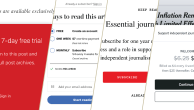
If half of tablet users go back and forth between the browser and apps, is the app model still worth investing in? Are there certain characteristics that even at this early stage differentiate apps users from browser users? The short answer is yes.
Those users who mainly use apps have distinct characteristics that may make them a lucrative target for the news industry. Those who mainly use apps for news are somewhat more likely to own an Apple iPad (94% own iPads compared with 83% who mainly use a browser). They are also more active tablet users in general; they are heavier news consumers, more likely to read in-depth articles and more satisfied with their tablet news experience-even to the point of saying the content they get here is worth more than content on other platforms. In other words, they are a kind of power user for this new device.

Those that use both the browser and apps equally tend to fall in middle, but are more like app users than browser users, suggesting then that they have realized the benefit of apps for certain kinds of news and the browser for others.
Fully 79%of primarily app users follow news all or most of the time versus 65% of primarily browser users and 77% of those that do both. And for app users, getting the news tops the list as their No.1 daily activity. Fully 81% of those who mainly use apps to get news, get news daily. That compares with 63% of those who mainly use a browser for news and 73% who use both (the No.1 activity for those who go through browsers was general Web browsing.)
Those who mainly use apps are also twice as likely as those who rely on a browser to read magazines daily on their tablet (13% versus 6% browser and 9% both-7% all news users). They are more likely to read back issues (44% versus 34%). And they are twice as likely as browser users to read more back issues on the tablet than they did in print. Having past content archived on their device, then, and the ease of scrolling through previous issues and articles may for this cohort work even better as an incentive for reading than the magazine cover that continues to stare at them on their nightstand.
Those who access news content mainly through apps are also twice as likely as those who rely on the traditional browser to say they spend more time getting the news than they did before they had their tablet-fully 43% of primarily app users say they spend more time with the news now compared with 19% of mainly browser users and 40% of those who use both apps and browsers equally for news. App users are more than three times as likely as browser users to regularly get news from sources they did not get news from before they had their tablet (58% versus 16% for browser users and 45% for both).

Along with the increased news usage for these app users comes a more fulfilling experience. For all three measures of value, app users were twice as likely as browser users to say the tablet news experience is a better one. More than half, 53%, say it is easier to learn new things on the tablet, compared with just a quarter of browser users (26%) and 49% those who use both equally. Nearly as many, 46%, report enjoying the news more on their tablet, more than twice the rate of browser users, 21% (38% for both).
And in the seven-day survey component, those that relied on apps said they preferred tablets the most for longer reading. Nearly two-thirds of both mainly app users and those who use both apps and browsers said they prefer their tablet for this kind of reading over any other platform, compared with 42% of those who go mainly through the browser for their news.
That satisfaction associated with using apps is also tied to more willingness to pay. More than a quarter, 27%, of mainly app users have paid for news on their tablet, compared with just 5% of primarily browser users and 20% of those who use both. While it may be expected that browser only users would not being paying for content, going through apps does not necessarily translate to paying for them as many news apps are still free. But the data also show that those who mainly use apps are more willing to say this news is worth more to them. Just under a quarter, 22%, say tablet news is worth more to them than news in other forms. While still a smaller overall percentage, it is twice that of those who only browse for news, 11%.

In legacy format, app users are paying more as well. More than half still subscribe to a print newspaper or magazine (56%) compared with 42% of browser users and 48% of those who use both.)
Who are power app users? While the demographics of primarily app users are mostly similar to those who mainly go through their browser for news, a few areas of difference stand out. Those who rely on apps are more highly educated (two-thirds are college graduates versus 55% of browser users) and are less likely to be younger than 30 years old (18% of those who mainly use apps are under 30 compared with 27% of those who mainly use browsers for their news). They also tend to be more liberal. App users for news report themselves as 40% liberal and 25% conservative, while browser users and news users overall are evenly split 30% and 30%.




